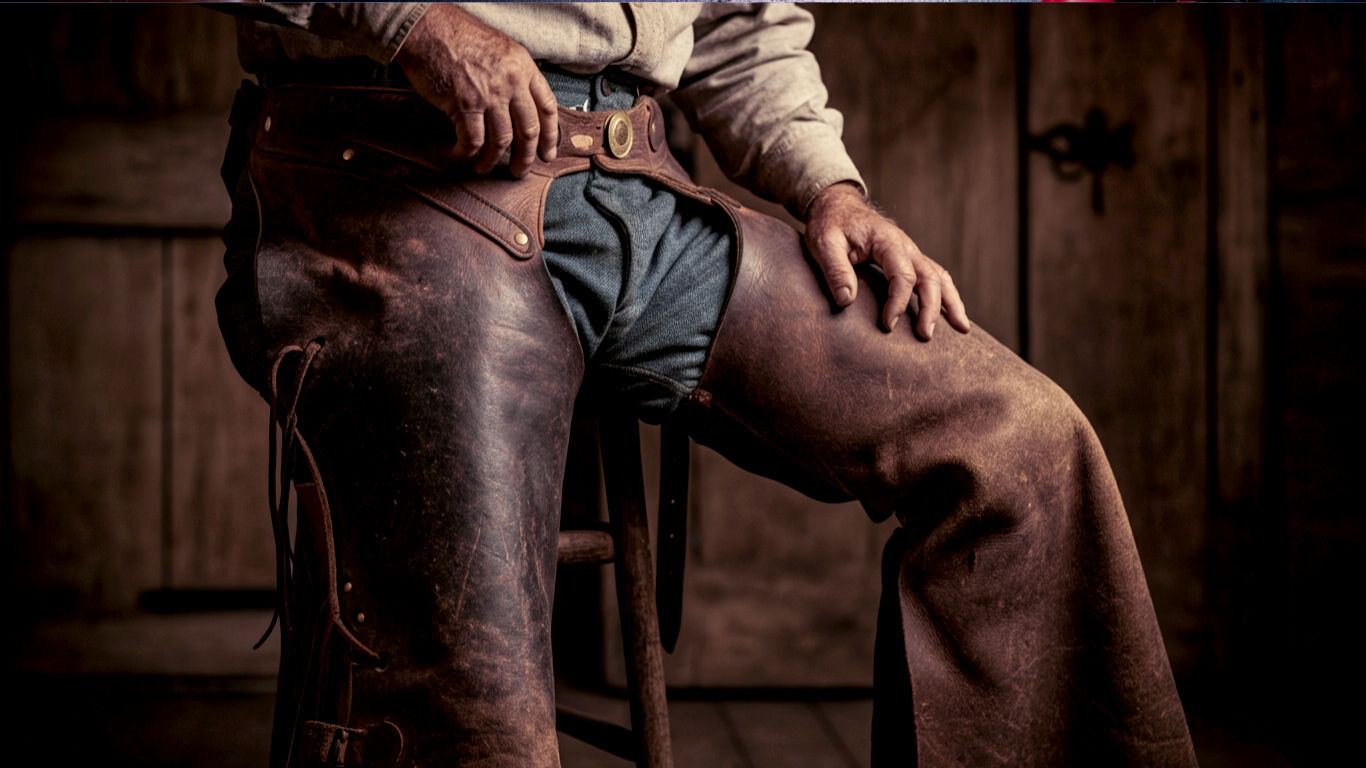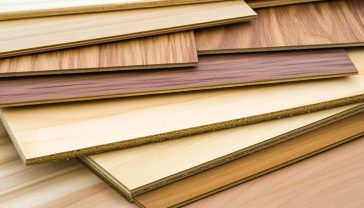The Definitive Guide to Cowboy Chaps: From Spanish Vaqueros to Modern Marvels
Explore the complete history of cowboy chaps. Learn why this iconic piece of Western gear was invented, how different styles evolved, and why it’s still used today.

This post may contain affiliate links. If you make a purchase through these links, we may earn a commission at no additional cost to you.
You’ve probably seen them in films. A lone rider, silhouetted against a dusty sunset, wearing those iconic leather leg coverings. They’re as much a part of the cowboy image as a Stetson hat or a pair of worn-in boots. But what exactly are they, and where did they come from?
They’re called chaps, and they’re far more than just a fashion statement. For centuries, these simple yet brilliant pieces of gear have been essential for anyone working on horseback in tough country. Think of them as a rider’s armour. They protect your legs from thorny bushes, biting insects, grumpy cattle, and the general scrapes and bruises that come with a hard day’s work.
This guide is going to take you on a journey through the fascinating history of cowboy chaps. We’ll start in old Spain, where the idea was first born, and travel across the ocean to the vast plains of America, where the classic cowboy as we know it came to be. We’ll look at how chaps changed over time, from simple pieces of cowhide to the fancy, decorated styles you see at rodeos today. We’ll explore the different types, what they’re made of, and how they became a powerful symbol of the Wild West—an image that has captivated people all over the world, even here in Britain.
So, saddle up. Let’s explore the story behind one of the most practical and enduring pieces of workwear ever invented.
What Exactly Are Chaps and What’s Their Point?
Before we dive into the history, let’s get the basics sorted. What are chaps, and why on earth would a cowboy need them?
At its simplest, chaps are a type of protective leg covering worn over trousers. They’re usually made from leather or other tough materials. They don’t have a seat or crotch; instead, they’re fastened around the waist with a belt and buckled around each leg. This design is clever because it gives you maximum protection on the front and sides of your legs while still being comfortable enough to wear in the saddle all day long. You can move freely, and you don’t get too hot.
The name “chaps” comes from the Spanish word chaparreras. This comes from chaparro, a type of thorny bush common in Spain and Mexico. So, the name literally means “leg protectors for thorny scrubland.” And that’s their main job: protection.
Imagine you’re a cowboy driving a herd of cattle across miles of untamed land. You’d be riding through all sorts of nasty stuff:
- Thorny Plants: Things like cactus, mesquite, and sagebrush would tear your ordinary trousers (and your legs) to shreds. Chaps act like a shield.
- Weather: When it’s cold, windy, or raining, a good pair of leather chaps adds an extra layer of warmth and keeps you dry.
- Rope Burns: If you’re using a lasso, a misplaced rope can give you a nasty burn. Chaps offer a vital layer of protection.
- Animals: A kick from a horse or a bump from a grumpy cow is much less painful when you have thick leather in the way.
- General Wear and Tear: Riding a horse for hours a day can wear out your jeans pretty quickly. Chaps protect your trousers, making them last much longer.
So, while they might look cool, chaps are first and foremost a practical piece of kit. They’re a tool, just like a saddle or a rope, designed to make a tough job a little bit easier and a lot safer.
The Journey of Chaps: From Spain to the American West
The story of chaps doesn’t start in Texas or Montana. It begins hundreds of years earlier and thousands of miles away, with the horsemen of Spain.
The Spanish Vaqueros: The Original Cowboys
Long before the American cowboy existed, there were the Spanish vaqueros. These were the expert horsemen and cattle herders of Spain, and their traditions date back centuries. When the Spanish came to the Americas in the 1500s, they brought their horses, their cattle, and their unique way of working with them.
In the vast, dry, and often thorny landscapes of what is now Mexico, the vaqueros needed something to protect their legs. Their solution was something called an armas, which means “weapons” or “armour” in Spanish. These were essentially large, heavy sheets of cowhide that were hung over the front of the saddle, like a protective apron for the rider’s legs.
The armas worked, but they were a bit clumsy. They were attached to the saddle, not the rider, which made it awkward if you had to get off your horse quickly. Over time, the vaqueros came up with a better idea. They created two separate leg coverings that they could wear themselves. They called them chaparreras. These early versions were often made from two pieces of leather stitched together, forming a tube that you could pull on over your trousers. They were a huge improvement.
Crossing the Border: Chaps Arrive in America
As cattle ranching spread north from Mexico into Texas, California, and the rest of the American West in the 1800s, so did the vaquero way of life. American settlers learned a huge amount from the Mexican vaqueros—how to ride, how to rope, and how to manage huge herds of cattle on the open range. They also adopted their gear, including their hats, their saddles, and, of course, their chaps.
The early chaps worn by American cowboys were very similar to the Mexican style. They were simple, practical, and built to last. Often, they were just made of plain, untanned cowhide with the hair left on. This made them extra tough and water-resistant. These early styles became known as “shotgun” chaps.
Shotgun Chaps: The First American Style
Shotgun chaps are the oldest and simplest style you’ll find in the American West. They get their name because each leg piece is a straight tube, a bit like the barrel of a shotgun. They’re a straightforward design that’s easy to put on—you just step into them one leg at a time.
- Design: They are cut straight and are fully enclosed around the leg, usually with a long zip or series of buckles running down the outside of the leg to fasten them.
- Fit: They have a close, snug fit. This is great for keeping you warm in cold weather and stopping your legs from getting snagged on branches.
- Use: They were perfect for the cowboys of the northern plains, in places like Wyoming and Montana, where the winters could be brutally cold. The snug fit provided excellent insulation.
For many years, shotgun chaps were the standard. But as cowboys started working in different parts of the West, with different climates and different challenges, new styles began to emerge.
The Evolution of Chaps: Different Styles for Different Jobs
The American West is a massive place, with everything from scorching deserts to snowy mountains. A cowboy in Arizona faced very different conditions to one in Oregon. As ranching spread, chaps began to change to suit the local environment. This led to the creation of several distinct styles, each with its own purpose.
Batwing Chaps: Freedom and Flair
As cowboys moved into the hotter, brush-filled country of Texas and the Southwest, they found that shotgun chaps were a bit too warm and restrictive. They needed something with a bit more ventilation that was also quick to get on and off. The answer was the batwing chap.
- Design: Batwing chaps are much wider and more open than shotguns. They wrap around the leg and are fastened with just a few straps and buckles on the outside. This leaves a big, flapping wing of leather—hence the name “batwing.”
- Fit: They have a very loose fit. This allows air to circulate, keeping the rider cool in hot weather. It also means you can put them on or take them off without having to remove your boots, which is a big time-saver.
- Use: The wide leather flaps provided excellent protection from thorny brush. When a cowboy rode through thick scrub, the batwings would push the branches aside. They also became popular in the world of rodeo, especially with bronc riders. The flapping leather adds to the visual spectacle of the ride.
Batwing chaps quickly became one of the most popular styles, and when you picture a classic movie cowboy, it’s often batwings they’re wearing.
Woolly Chaps: Beating the Cold
In the northern plains and the Rocky Mountains, staying warm was a matter of life and death. To deal with the freezing winters, cowboys developed woolly chaps.
- Design: These were essentially shotgun chaps made from hides with the hair left on. Angora goat, bear, and buffalo hides were popular choices. The long, shaggy hair was incredibly effective at trapping heat and shedding snow and rain.
- Look: Woollies are probably the most dramatic-looking type of chaps. They make the wearer look much bigger and more imposing. Teddy Roosevelt, the American president, was a big fan and was often photographed wearing a pair of spectacular woollies during his time as a rancher.
- Use: They were purely for cold-weather work. Wearing a pair of woollies in the Texas summer would be unbearable. But for a cowboy riding through a blizzard in Montana, they were an absolute lifesaver.
Chinks: The Light and Breezy Option
Sometimes, a full-length chap is just too much. For cowboys who needed protection but also wanted maximum freedom of movement and coolness, there were chinks.
- Design: Chinks are shorter and more open than other styles. They typically stop just below the knee and are open at the back of the leg. They are fastened with a couple of straps around the thigh and calf. They almost always have a long fringe along the bottom and sides.
- Fit: They are very light and airy, making them perfect for hot climates.
- Use: Chinks are really popular with modern-day working ranch hands and horse trainers, especially those who practice the “vaquero” or “buckaroo” style of horsemanship. They offer good protection for your thighs and knees but don’t get in the way when you’re doing groundwork or getting on and off your horse a lot. The fringe isn’t just for show either; it helps water run off them and can create a bit of movement to shoo flies away from the horse.
Farrier Chaps and Other Oddities
Besides the main styles, some specialised types of chaps were developed for specific jobs. Farrier chaps, for example, are worn by people who shoe horses. They are very heavy-duty and often have extra padding around the thigh and knee area to protect the farrier’s legs while they’re holding a horse’s hoof between their knees.
There are also motorcycle chaps, which evolved directly from the cowboy design. They serve the same purpose: protecting the rider’s legs from the wind, rain, road debris, and in the unfortunate event of a crash.
More Than Just Leather: Materials and Making
Traditionally, chaps were made from cowhide. It was cheap, readily available on a ranch, and incredibly tough. Early cowboys would often make their own, but as the cattle industry grew, so did the demand for professional gear. Skilled leatherworkers and saddle makers began producing high-quality chaps.
The process of making chaps is a real craft. It involves:
- Selecting the Hide: The leather has to be thick and strong but also flexible enough to be comfortable. The best parts of the hide are chosen for the main leg pieces.
- Cutting the Pattern: The leather is cut to a specific pattern depending on the style of chap being made (shotgun, batwing, etc.). This has to be done carefully to make sure they fit correctly.
- Tooling and Decoration: This is where the artistry comes in. Many chaps are decorated with intricate hand-tooled patterns, silver conchos (decorative metal discs), and different coloured leather overlays. This could be anything from a simple border to a complex design of flowers, brand logos, or the rider’s initials.
- Assembly: The pieces are stitched and riveted together. The belts, buckles, and straps are added. For shotgun chaps, heavy-duty zips are sewn in.
While leather is the classic material, modern chaps are sometimes made from synthetic materials like ultra-suede or vinyl. These are lighter, easier to clean, and come in a wider range of bright colours, which makes them popular with rodeo performers and show riders who want to stand out in the arena. However, for everyday ranch work, nothing beats the durability of good old-fashioned leather.
Chaps as a Symbol: The Cowboy Image
Chaps didn’t just protect the cowboy; they helped to define him. Along with the wide-brimmed hat and high-heeled boots, chaps became a key part of the cowboy uniform. This uniform wasn’t just about looking good; it was a sign that you belonged to a certain tribe. It showed that you were a skilled professional who understood the demands of life on the range.
When the Wild West shows of the late 19th and early 20th centuries became popular, performers like Buffalo Bill Cody helped to turn the working cowboy into a figure of entertainment and legend. The gear of the cowboy was exaggerated for dramatic effect. Chaps became flashier, often decorated with silver spots, long fringes, and bold designs.
This romantic image was then picked up by Hollywood. From the early silent films to the golden age of the Western, movie stars like John Wayne and Clint Eastwood made the cowboy a global icon. And their chaps were always part of the look. They symbolised toughness, independence, and a deep connection to the rugged landscape of the American West.
This powerful image has had a lasting impact. Cowboy style, including chaps, has influenced fashion for decades. Designers have borrowed the look for the runway, and musicians, from country singers to rock stars, have adopted elements of the cowboy aesthetic. The Village People’s “macho man” cowboy character, with his signature chaps, is a famous, if slightly cartoonish, example of how the look entered pop culture.
Even today, the image of a cowboy in chaps represents a set of values that many people find appealing: self-reliance, hard work, and a spirit of adventure.
Chaps in the Modern World: Still Working Hard
You might think that chaps are a relic of the past, something you only see in museums or old films. But that’s not the case at all. While the days of the great open-range cattle drives are mostly over, chaps are still an essential piece of equipment for many people today.
The Working Ranch Cowboy
On ranches all across North and South America, cowboys (and cowgirls) still ride out every day to look after cattle. And they still wear chaps for the exact same reasons their great-grandparents did: for protection from brush, weather, and whatever else the day throws at them. Modern ranch hands often favour chinks or simple, unadorned batwings—styles that are practical and comfortable for long hours in the saddle.
The Rodeo Star
In the thrilling world of rodeo, chaps are a must-have. They are worn by competitors in events like bull riding, saddle bronc, and bareback riding. Here, chaps serve two purposes. Firstly, they provide some protection. A bull’s horn or a rough landing can cause serious injury, and a thick layer of leather helps.
Secondly, they are a huge part of the show. Rodeo chaps are often incredibly flamboyant, made in bright, neon colours with long, flowing fringes and bold, sponsor-friendly logos. The flapping of the chaps exaggerates the rider’s movements, making a wild ride look even more spectacular for the crowd. They are as much a part of the rodeo costume as a sequined jacket is for a pop star.
The Enthusiast and the Show Rider
The appeal of the Western lifestyle has created a huge community of horse enthusiasts who ride in the Western style for pleasure. Many of these riders wear chaps, either for practical protection when trail riding or as part of the required look when competing in Western horsemanship shows. In the show ring, the fit and appearance of the chaps are very important. Show chaps are often custom-made to fit the rider perfectly, creating a long, clean leg line that is considered elegant and correct.
The Enduring Legacy of a Simple Idea
The story of chaps is a perfect example of how a simple, practical solution to a problem can evolve into something much more. It’s a story that starts with the hard-working vaqueros of Spain and Mexico, who simply needed a way to keep their legs from getting torn to pieces by thorns.
From those humble beginnings, the chaparreras travelled north and were adapted by the American cowboy, a figure who would become a legend. They were changed and refined to suit different landscapes and climates, resulting in a wonderful variety of styles, from the snug shotgun to the flamboyant batwing.
Along the way, they became more than just a tool. They became a symbol of a way of life—a life of hardship, independence, and adventure on the open range. They were part of the uniform that transformed the working man into a cultural icon, celebrated in shows, films, and fashion around the world.
And even now, in our modern, high-tech world, chaps endure. They are still worn by the men and women who work the land on horseback, still an essential part of the electrifying spectacle of rodeo, and still a beloved piece of gear for horse lovers everywhere.
So, the next time you see a pair of chaps, whether it’s in a classic Western film or at a modern equestrian event, you’ll know that you’re looking at more than just a pair of leather leggings. You’re looking at a piece of history—a direct link to the vaqueros, the cowboys, and the untamed spirit of the West. They are a testament to a simple, brilliant idea that has protected riders for centuries and continues to do so today.
Further Reading
For those interested in delving deeper into the world of cowboy culture and gear, these resources are highly respected:
- The National Cowboy & Western Heritage Museum: https://nationalcowboymuseum.org/ – A leading institution on the history of the American West.
- Western Horseman: https://westernhorseman.com/ – A long-standing magazine dedicated to ranching and Western riding.






